Page 17 of 36
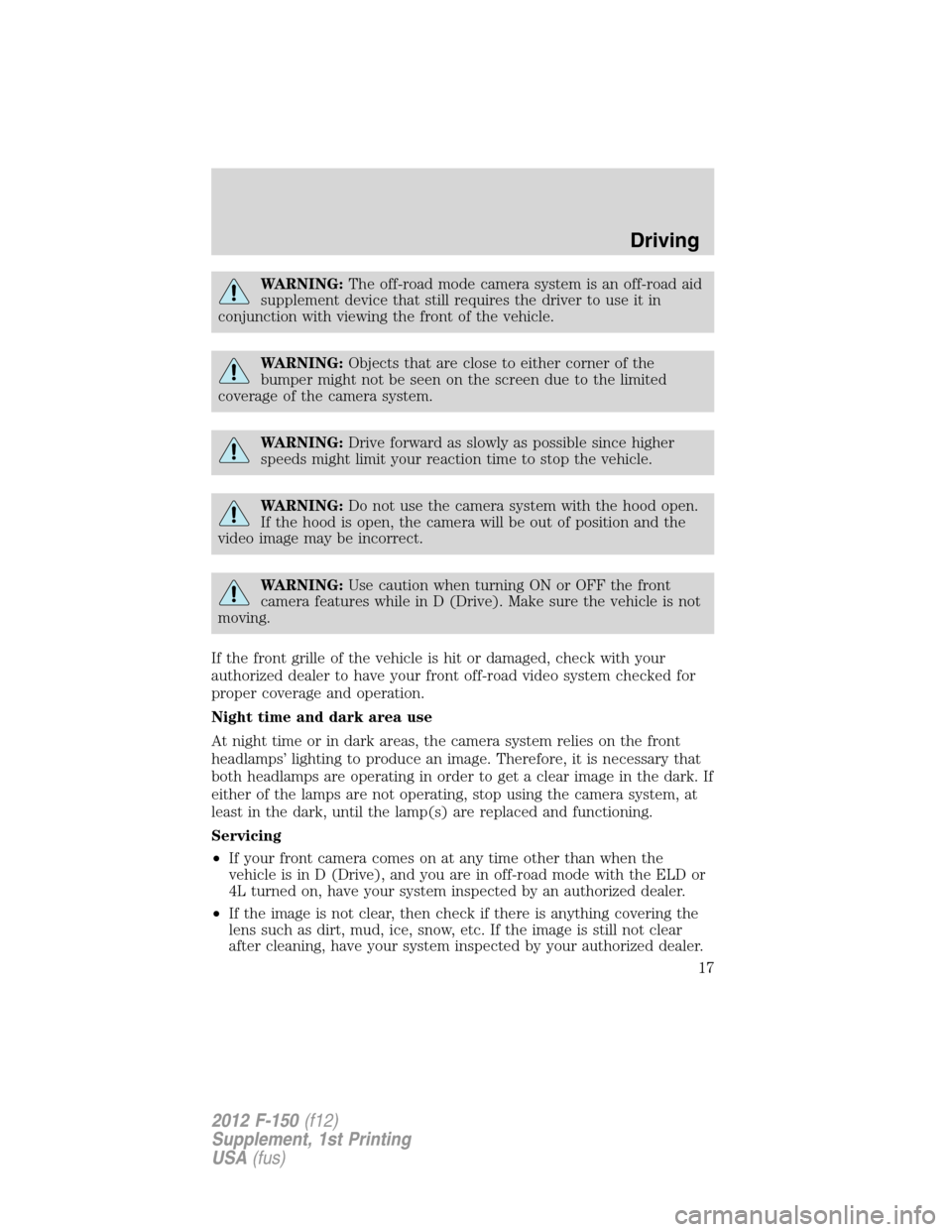
WARNING:The off-road mode camera system is an off-road aid
supplement device that still requires the driver to use it in
conjunction with viewing the front of the vehicle.
WARNING:Objects that are close to either corner of the
bumper might not be seen on the screen due to the limited
coverage of the camera system.
WARNING:Drive forward as slowly as possible since higher
speeds might limit your reaction time to stop the vehicle.
WARNING:Do not use the camera system with the hood open.
If the hood is open, the camera will be out of position and the
video image may be incorrect.
WARNING:Use caution when turning ON or OFF the front
camera features while in D (Drive). Make sure the vehicle is not
moving.
If the front grille of the vehicle is hit or damaged, check with your
authorized dealer to have your front off-road video system checked for
proper coverage and operation.
Night time and dark area use
At night time or in dark areas, the camera system relies on the front
headlamps’ lighting to produce an image. Therefore, it is necessary that
both headlamps are operating in order to get a clear image in the dark. If
either of the lamps are not operating, stop using the camera system, at
least in the dark, until the lamp(s) are replaced and functioning.
Servicing
•If your front camera comes on at any time other than when the
vehicle is in D (Drive), and you are in off-road mode with the ELD or
4L turned on, have your system inspected by an authorized dealer.
•If the image is not clear, then check if there is anything covering the
lens such as dirt, mud, ice, snow, etc. If the image is still not clear
after cleaning, have your system inspected by your authorized dealer.
Driving
17
2012 F-150(f12)
Supplement, 1st Printing
USA(fus)
Page 18 of 36
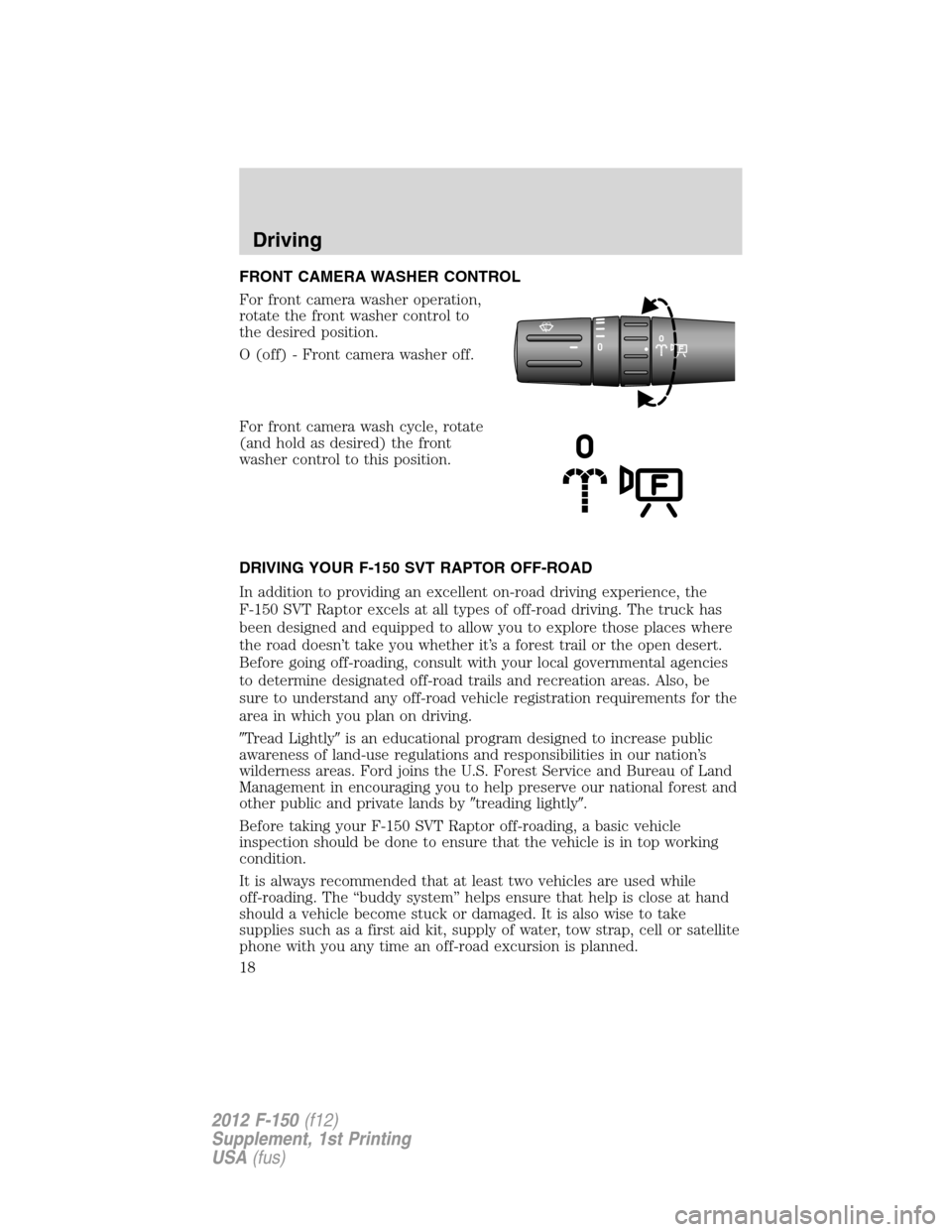
FRONT CAMERA WASHER CONTROL
For front camera washer operation,
rotate the front washer control to
the desired position.
O (off) - Front camera washer off.
For front camera wash cycle, rotate
(and hold as desired) the front
washer control to this position.
DRIVING YOUR F-150 SVT RAPTOR OFF-ROAD
In addition to providing an excellent on-road driving experience, the
F-150 SVT Raptor excels at all types of off-road driving. The truck has
been designed and equipped to allow you to explore those places where
the road doesn’t take you whether it’s a forest trail or the open desert.
Before going off-roading, consult with your local governmental agencies
to determine designated off-road trails and recreation areas. Also, be
sure to understand any off-road vehicle registration requirements for the
area in which you plan on driving.
�Tread Lightly�is an educational program designed to increase public
awareness of land-use regulations and responsibilities in our nation’s
wilderness areas. Ford joins the U.S. Forest Service and Bureau of Land
Management in encouraging you to help preserve our national forest and
other public and private lands by�treading lightly�.
Before taking your F-150 SVT Raptor off-roading, a basic vehicle
inspection should be done to ensure that the vehicle is in top working
condition.
It is always recommended that at least two vehicles are used while
off-roading. The “buddy system” helps ensure that help is close at hand
should a vehicle become stuck or damaged. It is also wise to take
supplies such as a first aid kit, supply of water, tow strap, cell or satellite
phone with you any time an off-road excursion is planned.
Driving
18
2012 F-150(f12)
Supplement, 1st Printing
USA(fus)
Page 19 of 36

WARNING:Off-roading can be extremely dangerous and carries
inherent risks that may not be preventable even with the best
precautions. Ford strongly recommends driving within your ability and
taking every safety precaution, including those found here and at other
off-road driving organizations such as the Best in the Desert Racing
(www.bitd.com) and SCORE International Off-Road Racing.
Off-road screen
The real-time status of the Raptor’s off-road systems can be continuously
monitored using the first off-road screen found under the Truck Apps
menu in the message center.
SeeMessage centerin theInstrument Clusterchapter of your Owner’s
Guide for more information.
Basic off-road driving techniques
•Grip the steering wheel with thumbs on the outside of the rim. This
will reduce the risk of injury due to abrupt steering wheel motions
that occur when negotiating rough terrain. Do not grip the steering
wheel with thumbs inside the rim.
•Throttle, brake and steering inputs should be made in a smooth and
controlled manner. Sudden inputs to the controls can cause loss of
traction or “upset” the vehicle, especially while on sloped terrain or
while crossing obstacles such as rocks or logs.
•Look ahead on your route noting upcoming obstacles, surface texture
or color changes or any other factors which may indicate a change in
available traction, and adjust the vehicle speed and route accordingly.
During pre-run, mark obstacles with GPS markers to ensure
appropriate speeds are used to avoid potential vehicle damage.
•When driving off-road, if the front or rear suspension is bottoming-out
and/or excessive contact with the skid-plates is encountered, reduce
vehicle speed to avoid potential damage to the vehicle.
•When running with other vehicles, it is recommended that
communication is used, and the lead vehicle notify other vehicles of
obstacles that could cause potential vehicle damage.
•Always keep available ground clearance in mind and pick a route that
minimizes the risk of catching the underside of the vehicle on an
obstacle.
Driving
19
2012 F-150(f12)
Supplement, 1st Printing
USA(fus)
Page 20 of 36

•When negotiating low speed obstacles, applying light brake pressure in
conjunction with the throttle will help prevent the vehicle from jerking
and will allow you to negotiate the obstacle in a more controlled
manner. Using 4L will also help with this.
•Use and equip supplemental safety equipment as discussed later in
this chapter.
•Please consult your local off-road group for other helpful tips.
•Off-roading requires a high degree of concentration. Even if your local
law does not prohibit alcohol use while driving off-road, Ford strongly
recommends against drinking if you plan to off-road.
Driving in mud
•Deep mud should be approached with caution especially if you are
driving in an unfamiliar area.
•If possible, test the depth of a mud hole before entering with the
vehicle.
•Keep in mind that obstacles and deep ruts may be hidden beneath the
surface of the mud.
•Proceed in a steady, controlled manner through deep mud while
maintaining momentum.
•If momentum is lost and you feel the vehicle becoming stuck, turning
the steering wheel back and forth (“sawing the wheel”)
1�4turn in
each direction may give the traction you need to clear the muddy
area.
•In higher speed areas with shallow mud, directional control will be
reduced in the muddy area much like on snow or ice. When
approaching such an area, be sure to slow to a speed which allows you
to maneuver as required by the conditions.
Driving in sand
WARNING:Tires must be returned to normal recommended tire
pressures before driving on pavement or hard surfaces. Failure
to properly maintain your tire pressure could increase the risk of tire
failure, loss of control, vehicle rollover and personal injury.
Driving
20
2012 F-150(f12)
Supplement, 1st Printing
USA(fus)
Page 21 of 36

Soft sand and dunes present a very unique driving challenge. Before
going on such a drive, some research is advised regarding proven
techniques and pitfalls inherent in driving in deep sand. Some general
points to consider:
•It is very difficult and in many cases impossible to navigate deep sand
with tire pressures which are appropriate for on-road driving. If you
decide to “air down” your tires, be advised that the tire pressure
monitoring light will illuminate. The tires must be returned to normal
recommended tire pressures before driving on pavement or hard
surfaces.
•Lower tire pressures are more likely to cause a debeading of the tire
during cornering. Avoid sharp or abrupt turns when you have
extremely low tire pressures.
•To help prevent becoming stuck in deep sand, avoid spinning the tires
or making abrupt maneuvers. Proceed in a controlled manner while
maintaining vehicle momentum.
•Avoid stopping or parking on inclines as this makes it more difficult to
resume driving.
Driving in deep snow
•Maintain vehicle momentum.
•Apply the throttle very gently to avoid spinning the tires. Spinning the
tires will potentially dig the vehicle deeper into the snow.
•Drive in a controlled manner, avoiding aggressive steering wheel
movements, and keep braking to a minimum.
•Extremely deep snow may cause the vehicle to�high center�causing
the vehicle to become stuck. Test the depth of the snow before trying
to drive through it.
Crossing obstacles
•Review the path ahead before attempting to cross any obstacle. It is
best if the obstacle is reviewed from outside the vehicle so that there
is a good understanding of terrain condition both in, front of, and
behind the obstacle.
•Approach obstacles slowly and slowly inch the vehicle over.
•If a large obstacle such as a rock cannot be avoided, choose a path
that places the rock directly under the tire rather than the
undercarriage of the vehicle. This will help prevent damage to the
vehicle.
•Ditches and washouts should be crossed at a 45 degree angle, allowing
each wheel to independently cross the obstacle.
Driving
21
2012 F-150(f12)
Supplement, 1st Printing
USA(fus)
Page 22 of 36
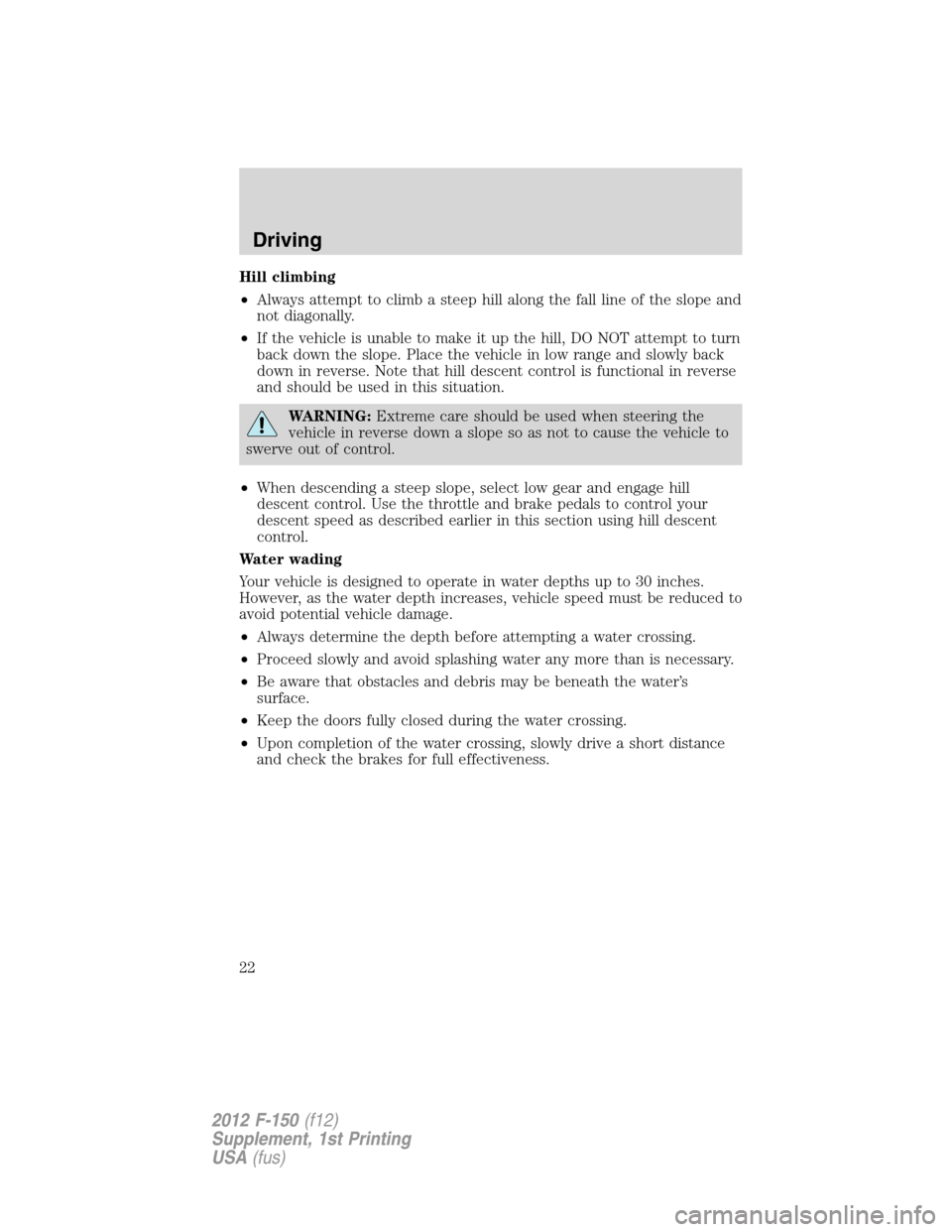
Hill climbing
•Always attempt to climb a steep hill along the fall line of the slope and
not diagonally.
•If the vehicle is unable to make it up the hill, DO NOT attempt to turn
back down the slope. Place the vehicle in low range and slowly back
down in reverse. Note that hill descent control is functional in reverse
and should be used in this situation.
WARNING:Extreme care should be used when steering the
vehicle in reverse down a slope so as not to cause the vehicle to
swerve out of control.
•When descending a steep slope, select low gear and engage hill
descent control. Use the throttle and brake pedals to control your
descent speed as described earlier in this section using hill descent
control.
Water wading
Your vehicle is designed to operate in water depths up to 30 inches.
However, as the water depth increases, vehicle speed must be reduced to
avoid potential vehicle damage.
•Always determine the depth before attempting a water crossing.
•Proceed slowly and avoid splashing water any more than is necessary.
•Be aware that obstacles and debris may be beneath the water’s
surface.
•Keep the doors fully closed during the water crossing.
•Upon completion of the water crossing, slowly drive a short distance
and check the brakes for full effectiveness.
Driving
22
2012 F-150(f12)
Supplement, 1st Printing
USA(fus)
Page 23 of 36
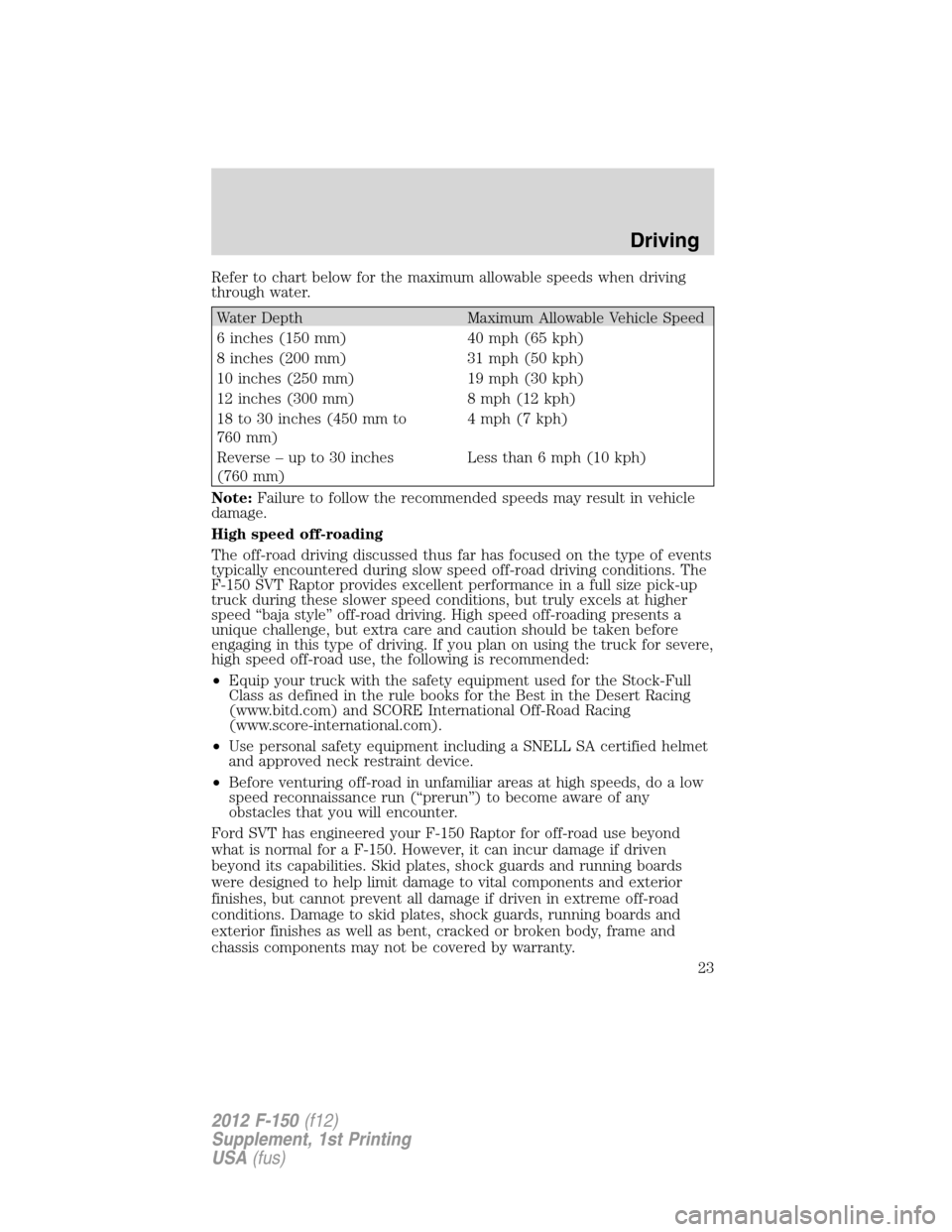
Refer to chart below for the maximum allowable speeds when driving
through water.
Water Depth Maximum Allowable Vehicle Speed
6 inches (150 mm) 40 mph (65 kph)
8 inches (200 mm) 31 mph (50 kph)
10 inches (250 mm) 19 mph (30 kph)
12 inches (300 mm) 8 mph (12 kph)
18 to 30 inches (450 mm to
760 mm)4 mph (7 kph)
Reverse – up to 30 inches
(760 mm)Less than 6 mph (10 kph)
Note:Failure to follow the recommended speeds may result in vehicle
damage.
High speed off-roading
The off-road driving discussed thus far has focused on the type of events
typically encountered during slow speed off-road driving conditions. The
F-150 SVT Raptor provides excellent performance in a full size pick-up
truck during these slower speed conditions, but truly excels at higher
speed “baja style” off-road driving. High speed off-roading presents a
unique challenge, but extra care and caution should be taken before
engaging in this type of driving. If you plan on using the truck for severe,
high speed off-road use, the following is recommended:
•Equip your truck with the safety equipment used for the Stock-Full
Class as defined in the rule books for the Best in the Desert Racing
(www.bitd.com) and SCORE International Off-Road Racing
(www.score-international.com).
•Use personal safety equipment including a SNELL SA certified helmet
and approved neck restraint device.
•Before venturing off-road in unfamiliar areas at high speeds, do a low
speed reconnaissance run (“prerun”) to become aware of any
obstacles that you will encounter.
Ford SVT has engineered your F-150 Raptor for off-road use beyond
what is normal for a F-150. However, it can incur damage if driven
beyond its capabilities. Skid plates, shock guards and running boards
were designed to help limit damage to vital components and exterior
finishes, but cannot prevent all damage if driven in extreme off-road
conditions. Damage to skid plates, shock guards, running boards and
exterior finishes as well as bent, cracked or broken body, frame and
chassis components may not be covered by warranty.
Driving
23
2012 F-150(f12)
Supplement, 1st Printing
USA(fus)
Page 24 of 36
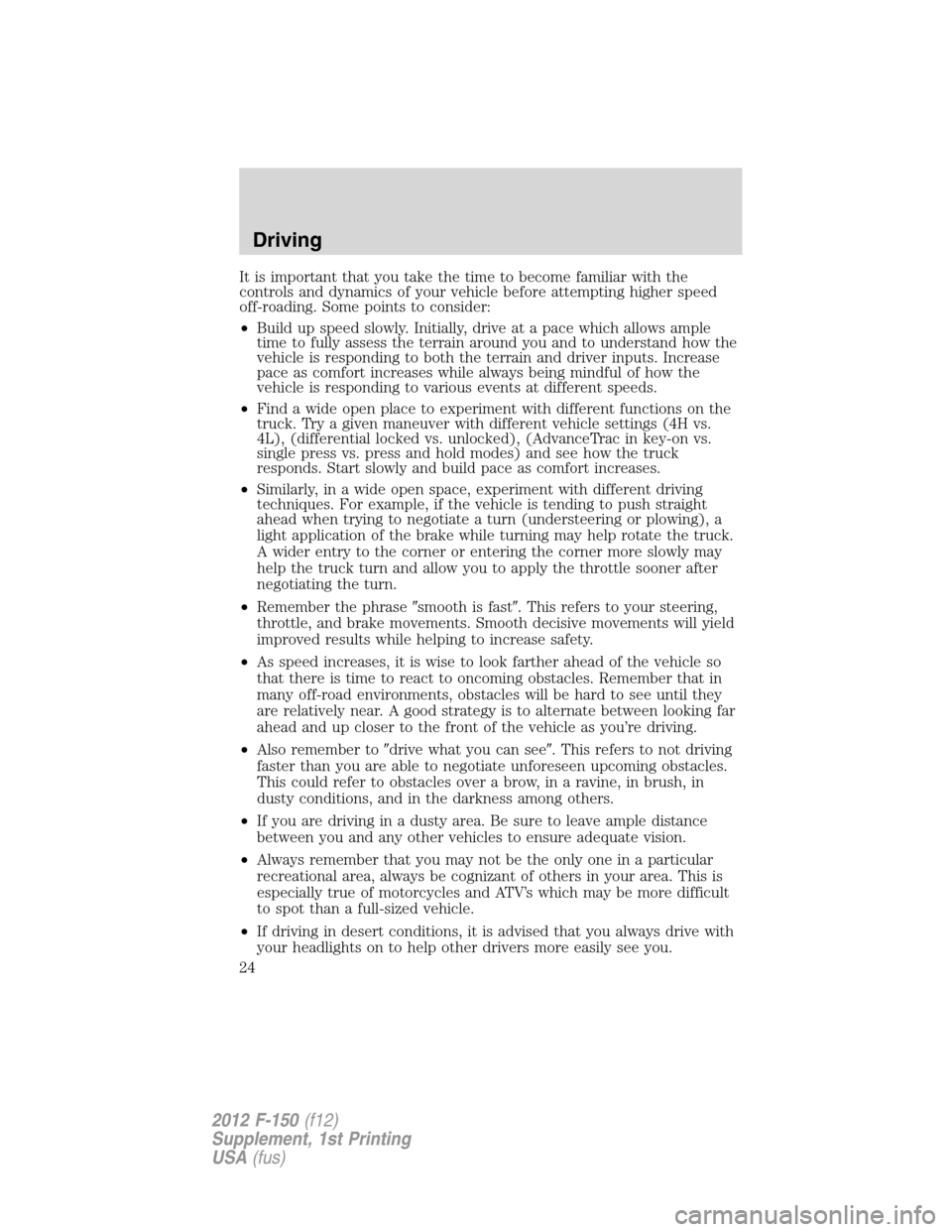
It is important that you take the time to become familiar with the
controls and dynamics of your vehicle before attempting higher speed
off-roading. Some points to consider:
•Build up speed slowly. Initially, drive at a pace which allows ample
time to fully assess the terrain around you and to understand how the
vehicle is responding to both the terrain and driver inputs. Increase
pace as comfort increases while always being mindful of how the
vehicle is responding to various events at different speeds.
•Find a wide open place to experiment with different functions on the
truck. Try a given maneuver with different vehicle settings (4H vs.
4L), (differential locked vs. unlocked), (AdvanceTrac in key-on vs.
single press vs. press and hold modes) and see how the truck
responds. Start slowly and build pace as comfort increases.
•Similarly, in a wide open space, experiment with different driving
techniques. For example, if the vehicle is tending to push straight
ahead when trying to negotiate a turn (understeering or plowing), a
light application of the brake while turning may help rotate the truck.
A wider entry to the corner or entering the corner more slowly may
help the truck turn and allow you to apply the throttle sooner after
negotiating the turn.
•Remember the phrase�smooth is fast�. This refers to your steering,
throttle, and brake movements. Smooth decisive movements will yield
improved results while helping to increase safety.
•As speed increases, it is wise to look farther ahead of the vehicle so
that there is time to react to oncoming obstacles. Remember that in
many off-road environments, obstacles will be hard to see until they
are relatively near. A good strategy is to alternate between looking far
ahead and up closer to the front of the vehicle as you’re driving.
•Also remember to�drive what you can see�. This refers to not driving
faster than you are able to negotiate unforeseen upcoming obstacles.
This could refer to obstacles over a brow, in a ravine, in brush, in
dusty conditions, and in the darkness among others.
•If you are driving in a dusty area. Be sure to leave ample distance
between you and any other vehicles to ensure adequate vision.
•Always remember that you may not be the only one in a particular
recreational area, always be cognizant of others in your area. This is
especially true of motorcycles and ATV’s which may be more difficult
to spot than a full-sized vehicle.
•If driving in desert conditions, it is advised that you always drive with
your headlights on to help other drivers more easily see you.
Driving
24
2012 F-150(f12)
Supplement, 1st Printing
USA(fus)